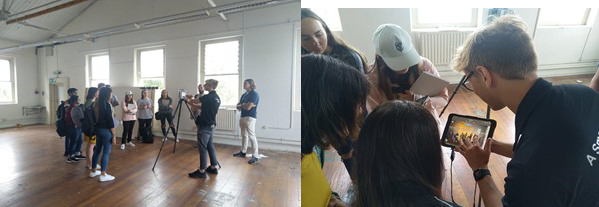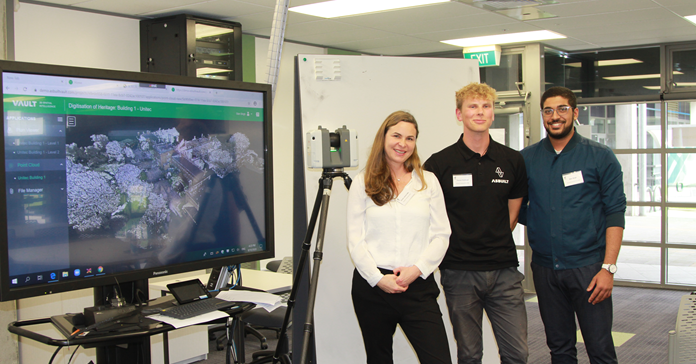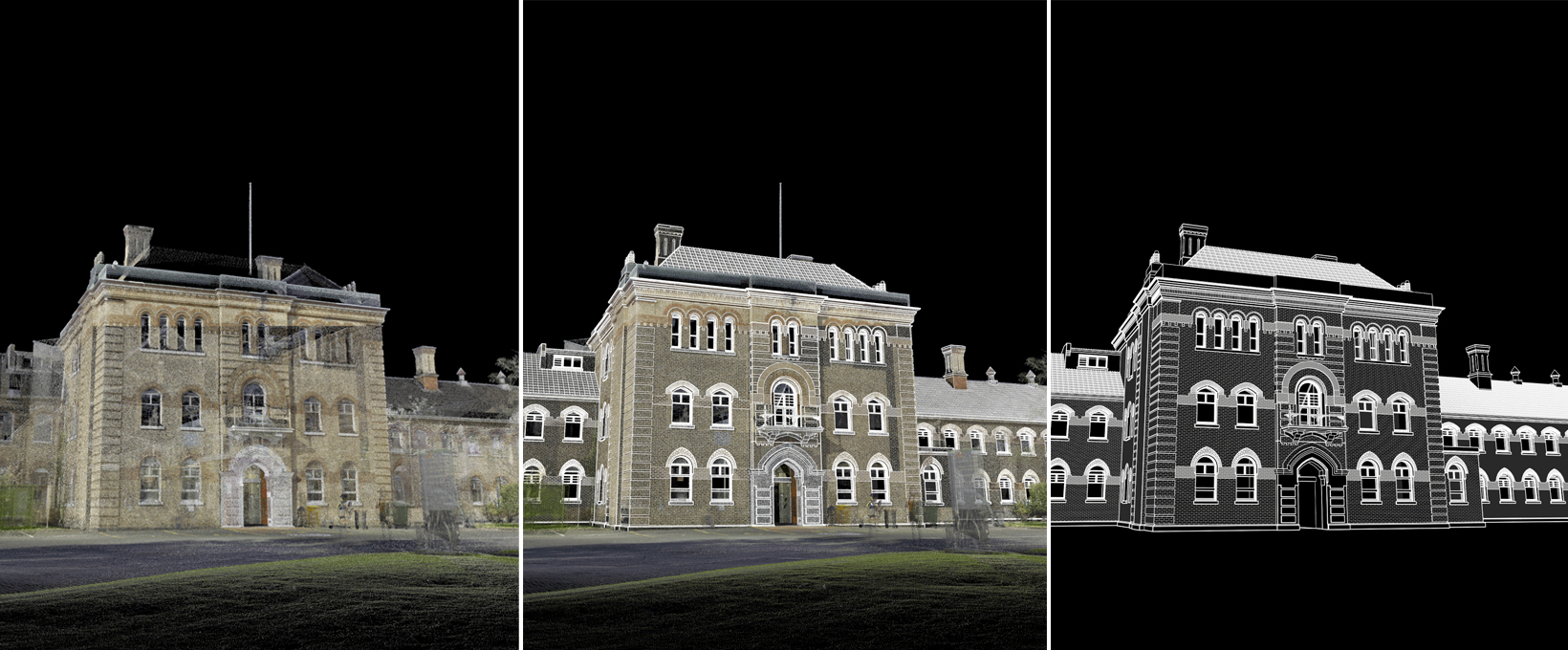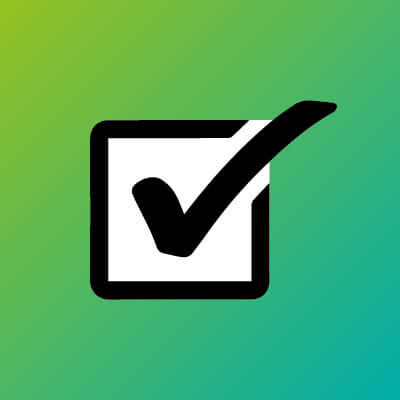What we do
Modern technologies for digital heritage include 3D laser scanning; Photogrammetric 3D models of buildings, sites, and objects; and HBIM (historic building information modeling) software.
Not all heritage can be physically retained and much has been lost. The use of modern digital technologies not only facilitates and improves conservation practices and processes, but also enables the creation of a digital database of heritage. The Unitec Digital Heritage Research Centre investigates how to:
- Raise awareness and implement the utilisation of modern technologies for digital heritage in the related professions and sectors; architecture, heritage conservation, and government.
- Improve education in the use of modern technologies for digital heritage.
- Improve the implementation of modern technologies for digital heritage.
Benefits of digital scanning include:
- Having a “digital heritage” made up of computer-based materials of enduring value, accessible to future generations.
- A more strategic approach to heritage conservation can be developed so that the continuity of heritage buildings is maintained. For example, digital data better enables close monitoring of the rate of decay or damage to structures over time.
- A digital library of information exists which can be used to remediate the building in the case of natural or other disasters. For example, digital data gives precise measurements that can be used to repair and preserve irreplaceable heritage sites.
- Assists the new generation of architects and other professionals to learn about the importance of heritage protection and preservation and how to work collaboratively with local communities and agencies towards a common goal.
- Digital data enables the creation of digital models and virtual tours, which allow remote access to inaccessible or dangerous areas from specialists nationally and across the world through virtual reality.
- Retaining built heritage and adaptive reuse of buildings prevents established embodied energy in wholesale buildings and their materials from being sent to landfills, with climate change in mind.
- Technical data (Point Clouds and BIM) can be used to create interactive and online-based materials that can be shared with contractors on a global scale, minimising site visits and reducing contractor carbon footprint.
Current research
The research centre is currently working on a leading-edge 3D-modelling exercise, capturing historical and heritage buildings. It exemplifies collaboration between education, community, and industry and sets a new bar for digital technologies in domestic conservation practice thought in architectural education institutions. The project involves the scanning (using LiDar and Photogrammetry technology) and 3D-modelling of ‘Building 1’ that was part of the Unitec Mt Albert campus. This heritage building was formerly Oakley or Carrington Hospital (originally known as a Lunatic Asylum of the ‘Whau’).
The project will assist the research centre in better understanding:
- What levels of understanding of Digital Heritage (tools, equipment, software) there is in our professionals/ architects/ heritage architects/cultural heritage experts overall?
- What buildings (heritage buildings) should be prioritised to be digitally recorded?
- How can the practice of dealing with heritage buildings in New Zealand be enhanced through the use of Modern Digital Technologies?

Caption: LiDar scanning workshops with industry partners and students. Source: Unitec Research Project “Digitalisation of Heritage in NZ”.

Point cloud of the main façade of Building One. Source: Unitec Research Project “Digitalisation of Heritage in NZ”

Unitec Research Project “Digitalisation of Heritage in NZ” inaugural (core) team members: Renata Jadresin Milic; Thomas Reutlinger, Sian Singh.
Research publications
Published research from the Digital Heritage research centre.
Architectural History and Sustainable Architectural Heritage Education: Digitalisation of Heritage in New Zealand.
Sustainability 2022, 14, 16432. https://doi.org/10.3390/su142416432, webpage: https://www.mdpi.com/2071-1050/14/24/16432.
Date published: 8 December 2022
Authors: Renata Jadresin Milic, Peter McPherson, Graeme McConchie,Thomas Reutlinger, and Sian Singh.
The Digital Realm and New Zealand Heritage: Bringing Architectural Theory and Practice into the Modern Architects Workflow.
“Heritage Bites” - Digital lunchtime talks on historic heritage matters, Historic Places Aotearoa and ICOMOS New Zealand.
View the presentation on YouTube.
Date published: 1 April 2022.
Authors: Dr Renata Jadresin Milic, Thomas Reutlinger, Sian Singh.
The Digital Realm and New Zealand Heritage – Challenges and Potentials.
Paper presented at the Rangahau Horonuku Hou New Research Landscapes, MIT - Unitec Research Symposium 2021, Auckland, Unitec New Zealand.
Date published: December 2021.
Authors: Dr Renata Jadresin Milic, Thomas Reutlinger, Sian Singh.
Teaching Architectural History Starting From Current Events: Digitalisation of Heritage in New Zealand.
Paper presented at What if? What next? Speculations on History’s Futures. 37th Annual Conference of the Society of Architectural Historians, Australia and New Zealand, Perth.
Date published: November 2020.
Authors: Dr Renata Jadresin Milic, Peter McPherson, Graeme McConchie
Digitalisation of New Zealand Architectural Heritage: Bringing Architectural History and Theory into the Virtual Realm.
Paper presented at the Whaowhia te kete mātauranga - Fill the basket of knowledge. Unitec Research Symposium 2020, Auckland, Unitec New Zealand.
Date published: October 2020.
Authors: Dr Renata Jadresin Milic, Thomas Reutlinger, Sian Singh.
Preservation issues and controversies: Challenges of underutilised and abandoned places.
Link to article in Research bank.
In A. Ghaffarianhoseini, A. Ghaffarianhoseini and N. Nasmith (Ed.), Imaginable Futures: Design Thinking, and the Scientific Method, 54th International Conference of the Architectural Science Association 2020, Auckland University of Technology, Auckland, New Zealand (pp. 885-894).
Date published: October 2020.
Authors: Julia Hamilton, Dr. Renata Jadresin Milic.
Contact the Digital Heritage Research Centre
Email: Dr Renata Jadresin Milic rjadresinmilic@unitec.ac.nz
Physical address: Unitec, Te Whare Wānanga o Wairaka, 139 Carrington Road, Mount Albert, Auckland New Zealand.
Our research partners
Digital heritage is a rapidly changing field, and research in this space must be well-connected to collaborators and new technologies. Our Research Centre uses multidisciplinary partnering and long-term collaborations with a broad range of partners, including national and international universities, polytechnics, research institutes, government bodies, industry, and community.
National collaboration partners:
- Professor Regan Potangaroa (Massey University, Auckland).
- Mari McKee and Tracey Hartley (Salmond Reed Architects).
- Simon Mobley and Freddie Nodalo (AsBuilt Digital).
- Malcolm Archbold, (Survis limited - The legacy of his contribution to the establishment of this centre will endure, despite his recent passing).
- Chirag Jindal (Arclab).
- Graeme Bennett and Chris Casey (Point Chevalier Community Trust).
- Sam Smith (Woods).
- Tim Stevenson (Archifact – Architecture and conservation limited).
International collaboration partners:
- Politecnico di Milano, Italy.
- University of L’Aquila, Italy.
- University of Firenze, Italy.
- Cracow University of Technology, Poland.
- Norwegian University of Science and Technology, Norway.
- University of Belgrade, Serbia.
- Iowa State University, USA.
- Vanderbilt University, USA.
- The University of Queensland, Australia.
- INTBAU Australia.


